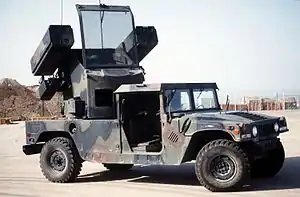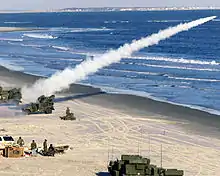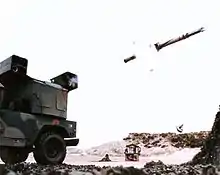AN/TWQ-1 Avenger
The Avenger Air Defense System, designated AN/TWQ-1 under the Joint Electronics Type Designation System, is an American self-propelled surface-to-air missile system which provides mobile, short-range air defense protection for ground units against cruise missiles, unmanned aerial vehicles, low-flying fixed-wing aircraft, and helicopters.[2]
| AN/TWQ-1 Avenger | |
|---|---|
 An Avenger air defense missile system. | |
| Type | Self-propelled anti-aircraft gun Mobile air defense missile system Surface to air missile |
| Place of origin | United States |
| Service history | |
| In service | 1989–present |
| Used by | United States Army United States Marine Corps |
| Production history | |
| Manufacturer | Boeing |
| Produced | 1980s–present |
| No. built | Over 1,100[1] |
| Specifications | |
| Mass | 8,600 lb (3900 kg) |
| Length | 16 ft 3 in (4.95 m) |
| Width | 7 ft 2 in (2.18 m) |
| Height | 8 ft 8 in (2.64 m) |
| Crew | 2 (Basic), 3 (STC) |
Main armament | 4/8 FIM-92 Stinger missiles |
Secondary armament | .50 M3P machine gun |
| Engine | Detroit Diesel cooled V-8 135 hp (101 kW) |
Operational range | 275 miles (443 km) |
| Maximum speed | 55 mph (89 km/h) |
The Avenger was originally developed for the United States Armed Forces and is currently used by the U.S. Army. The Avenger system was also used by the U.S. Marine Corps.[3]
History
Originally developed as a private venture by Boeing in the 1980s, the Avenger was developed over a period of only 10 months from initial concept to delivery for testing to the U.S. Army. Initial testing was conducted in May 1984 at the Army's Yakima Training Center in the U.S. state of Washington. During testing three FIM-92 Stinger missiles were fired. During the first test firing the system achieved a direct hit while moving at 20 mph (30 km/h).[2]
The second test firing, conducted at night while stationary, also achieved a direct hit. The third test firing, conducted while on the move and in the rain, did not achieve a direct hit, but did however, pass within the missile's kill range and the shot was scored as a tactical kill. All three test shots were conducted by operators who had never fired the missile before.[2]
In 1987, the U.S. Army awarded the first production contract for 325 units.[4] In 1989, the system began its Initial Operational Test and Evaluation (IOT&E) series of tests. The tests were conducted in two stages with Stage 1 consisting of acquisition and tracking trials at Fort Hunter Liggett, California and Stage 2 consisting of live-fire testing at White Sands Missile Range, New Mexico. In February 1990, the Avenger system was deemed operationally effective and began replacing the M163 and M167 VADS.[5] Two variants were deployed based on the Humvee chassis: M998 HMMWV Avenger and M1097 Heavy HMMWV Avenger.
The first operational deployment of the system occurred during the buildup for the Persian Gulf War. With the success of this deployment, the U.S. Army signed an additional contract for another 679 vehicles, bringing the total order to 1,004 units. The Avenger was again successfully deployed in support of NATO operations during the Bosnian War.[4] The Avenger system received widespread public exposure when it was placed around the Pentagon during the first anniversary of the September 11 attacks of 2001.[6] The Avenger was also deployed during the U.S. military's operations in Afghanistan and Iraq.[4]
In 2004, the U.S. Army had 26 battalions with Avenger Short-Range Air Defense (SHORAD) capabilities, but prioritization of other weapon systems during operations in Afghanistan and Iraq caused that number to drop to nine by early 2017, of which two were within the active force and seven were in the Army National Guard.[7] Of the over 1,100 Avengers built, only about 400 remain in service.[8] In March 2018, in response to renewed Russian aggression since the 2014 annexation of Crimea, the 678th Air Defense Artillery Brigade deployed to Europe, the first time an American air defense unit had been sent there since the Cold War. The Army plans to deploy 72 Avenger sets to support U.S. European Command.[9]
During protest of the Dakota Access Pipeline near Standing Rock, the North Dakota National Guard deployed an Avenger as an observation platform. It was employed for over a month to observe areas within Morton County where numerous incidences of criminal trespass and mischief were occurring. The unarmed Avenger was used to support public safety in southern Morton County. The Avenger system was removed in order to deescalate any tensions its presence may have caused.[10]
In April 2017, an Avenger fired Stingers at two UAVs in a test on Eglin Air Force Base, marking the missile's first interception of a UAV target. While Stingers are usually loaded with direct impact warheads for use against aircraft and cruise missiles, these were equipped with proximity fuzes that enabled them to detonate near the target, giving them the ability to destroy small UAVs. Since small UAVs do not produce large heat signatures, the Avenger uses a laser rangefinder in combination with an antenna on the warhead to direct the missile on target. The Stingers shot down an MQM-170C Outlaw and a smaller, unidentified system, demonstrating the fuze's ability to detect and destroy moving mini-drones weighing as little as 2–20 kg (4.4–44.1 lb).[11][12][13]
On 30 September 2020, the U.S. Army awarded General Dynamics a contract to deliver the Interim Maneuver SHORAD (IM-SHORAD), a Stryker armored vehicle fitted with heavier weapons to replace the outdated, unarmored, and undergunned Avenger Humvee.[14]
Overview

The Avenger comes mainly in three configurations, the Basic, Slew-to-Cue, and the Up-Gun.
The Basic configuration consists of a gyro-stabilized air defense turret mounted on a modified heavy Humvee. The turret has two Stinger missile launcher pods, each capable of firing up to 4 fire-and-forget infrared/ultraviolet guided missiles in rapid succession.[2] The Avenger can be linked to the Forward Area Air Defense Command, Control, Communications and Intelligence (FAAD C3I) system, which permits external radar tracks and messages to be passed to the fire unit to alert and cue the gunner.[5]
The Slew-to-Cue (STC) subsystem allows the commander or gunner to select a FAAD C3I reported target for engagement from a display on a Targeting Console developed from VT Miltope's Pony PCU.[15] Once the target has been selected, the turret can be automatically slewed directly to the target with limited interaction by the gunner.[5]
The Up-Gun Avenger was developed specifically for the 3rd Armored Cavalry Regiment for the Regiment's 2005 deployment to Iraq. The modification was designed to allow the Avenger to perform unit and asset defense in addition to its air defense mission. The right missile pod was removed and the M3P .50 cal machine gun was moved to the pod's former position. This allowed for the removal of the turret's cab safety limits which enabled the gun to be fired directly in front of the HMMWV.[16] Eight of the unit's Avengers were modified to this configuration.[4] With the 3rd ACR's redeployment from Iraq, the Up-Gun Avenger completed its role in Operation Iraqi Freedom and the Avengers have been scheduled to be converted back to STC systems.
Variants
Boeing/Shorts Starstreak Avenger

Boeing teamed with Shorts Brothers PLC (now part of Thales) to offer an Avenger system in which one Stinger pod was replaced with a pod of four Starstreak Hyper-velocity laser-guided missiles, in the hopes of attracting a U.S. Army contract under the Forward Area Air Defense System Line-of-Sight Rear (FAADS-LOS-R) program. Test installation was carried out in mid-1990 and firing trials followed from mid-1991 in the U.K. Starstreak would have complemented the Stinger by improving the overall systems ability to deal with low hovering helicopters which frequently do not provide enough contrast for lock-on by infrared guided missiles. Starstreak also has the ability to be used against un-armored and lightly armored ground vehicles.
Boeing/Matra Guardian
In the 1990s Boeing teamed with Matra of France to offer the Avenger modified by the substitution of standard triple launcher boxes for Matra Mistral missiles in place of the quadruple Stinger pods of the standard Avenger. One demonstrator vehicle was built in 1992 and test firings took place in France. The project was dropped around 1997.
Avengers during the Iraq War
Due to the lack of serious airborne threats during much of the Iraq War, along with the pressing need for ground assets for combat roles such as convoy protection, the Avenger was pressed into this role.[17] The FLIR/laser rangefinder combined with the .50 cal machine gun has proved to be very effective, but was limited by no-fire zones, particularly to the front of the vehicle.[18] A program was instituted to remove one of the missile pods and move the machine gun to that position to enable a 360° field of fire.[19] The upgrade also increased the ammunition capacity to 650 rounds.
Avenger DEW
Another potential variant proposed by Boeing is an Avenger with a Directed Energy Weapon (DEW). Boeing completed an initial test of a 1 kilowatt laser mounted where the right missile pod would be.[20] The M3P .50 cal has been replaced by the M242 Bushmaster as its close defense weapon.
Avenger Multi-Role Weapon System
Test firing demonstrations took place in 2004 of this variant modified by re-locating the M3P machine gun over the turret cab to allow a 360-degree field of fire, increasing ready-use machine gun ammunition stowage to 600 rounds, and providing the option to substitute launchers for 2 FGM-148 Javelin missiles in place of 1 Stinger pod.[21]
Accelerated Improved Interceptor Initiative (AI3)
In February 2012, Raytheon was awarded a contract to develop the AI3, a modified AIM-9 Sidewinder missile mounted on the Avenger launcher, to perform counter rocket, artillery, mortar (C-RAM), counter unmanned aerial vehicle (C-UAV), and counter cruise missile duties.[22]
In 2013, the US Army decided to not buy the system.[23]
In August 2014, the system successfully intercepted a UAV and cruise missile target featuring a semi-active radar homing seeker in a test.[24]
Other variants
Boeing have proposed that the Avenger PMS turret could be mounted on other vehicles such as Unimog truck, BV-206 all-terrain vehicles, M113 APC, and M548 tracked cargo carrier as well as being used as a stationary ground mount on a pallet for defense of static targets. The Avenger PMS has been demonstrated with a mock-up of two 70 mm helicopter-type rocket pods carrying a total of 36 rockets to give the system greater multi-mission utility. Other missiles such as the Bofors RBS 70/Bolide have been proposed for use on the Avenger PMS.
In March 2017, Boeing revealed a modernized Avenger system fitted with AIM-9X Sidewinder and Longbow Hellfire missiles on the sides and a directed energy weapon affixed to the top. It is also planned to be integrated onto other platforms including the JLTV, Stryker, and Bradley Fighting Vehicle.[25] While Boeing had configured a Stryker with the Avenger turret to fulfill the Army's Interim Maneuver-Short-Range Air Defense (IM-SHORAD) requirement, the Army ultimately decided against the idea, feeling it would require major modifications to the vehicle and because of the company's desire for the service to supply the turrets, of which there were a limited amount existing readily in the inventory.[26]
Specifications
Dimensions
- Length – 16 ft 3 in (4.95 m)
- Width – 7 ft 2 in (2.18 m)
- Height – 8 ft 8 in (2.64 m)
- Weight – 8,600 lb (3,900 kg)
- Crew – 2 (Basic), 3 (STC)
- Road speed – 55 mph (89 km/h)
- Range – 275 miles (440 km)
- Engine – Detroit Diesel cooled V-8
- Engine power output – 135 hp (99 kW)
Sensors
- Forward Looking Infrared Receiver (FLIR)
- Eye Safe Laser rangefinder
- Optical sight
Weapons
- 4/8 ready-to-fire FIM-92 Stinger missiles
- 1 M3P machine gun built by FN Herstal,[27] a variant of the Browning AN/M3 developed for aviation use during World War II. It is a .50 caliber machine gun with an electronic trigger that can be fired from both the remote control unit (RCU) located in the drivers cab, and from the handstation located in the Avenger turret. It has a 950 to 1200 rounds per minute firing rate. Loads one box of 200–250 rounds at a time.
Operators
 Bahrain
Bahrain Egypt
Egypt Iraq
Iraq Taiwan - Avenger batteries have been upgraded by integrating CS/MPQ-90 Bee Eye radars[28]
Taiwan - Avenger batteries have been upgraded by integrating CS/MPQ-90 Bee Eye radars[28] United States – U.S. Army and U.S. Marine Corps
United States – U.S. Army and U.S. Marine Corps Chile
Chile
See also
- Anti-aircraft warfare
- Atılgan PMADS
- FIM-92 Stinger
- Joint Electronics Type Designation System
- United States Army Aviation and Missile Command
Comparable systems
- Type 92 Yitian
- Type 93 Surface-to-air missile
- 9K35 Strela-10 (SA-13 Gopher)
- 9K31 Strela-1 (SA-9 Gaskin)
References
- "AN/TWQ-1 Avenger Number of Built". Archived from the original on 2019-10-31. Retrieved 2020-05-15.
- Avenger AN/TWQ-1 (United States) - Jane's Land Based Air Defense
- - Details of Avenger use by the USMC
- Avenger Low Level Air Defense System, USA- Army Technology
- Avenger (Pedestal Mounted Stinger) - GlobalSecurity.org
- Stinger Missile In Nation's Capital - Life
- Short-range air defense making a fast comeback – Defensenews.com, 10 February 2017
- Boeing Upgrades Air Defense Vs. Russians: Avenger SHORAD - Breakingdefense.com, 14 April 2017
- US air defense artillery brigade back in Europe for first time since the Cold War. Army Recognition. 3 April 2018.
- http://www.thedailybeast.com/articles/2017/01/18/national-guard-pulls-missile-launchers-away-from-standing-rock-protesters.html
- Famous Army Stinger Missile Proximity Fuse Now Destroys Moving Mini-Drones - Scout.com/Military, 2 June 2017
- Proximity-fuzed Stinger Missiles Down Small Unmanned Systems - Defensemedianetwork.com, 2 June 2017
- Stinger missiles intercept drones in a first with new fuzes - C4ISRnet.com, 7 June 2017
- GDLS Gets $1.2B For 144 Army Anti-Aircraft Strykers. Breaking Defense. 1 October 2020.
- Pony PCU (United States) - Janes C4I Systems
- Boeing Frontiers Online - Boeing team gives troops in Middle East extra firepower
- Air Defense Artillery April-June 2005 Archived March 27, 2009, at the Wayback Machine
- FM 44-44 - AVENGER PLATOON, SECTION, AND SQUAD OPERATIONS
- "Giving Troops Extra Firepower - Boeing". Archived from the original on 2006-03-18. Retrieved 2006-09-12.
- Pappalardo, Joe (November 13, 2007). "Boeing Tests Laser-Mounted Humvee as IED Hunter". Popular Mechanics. Archived from the original on 2007-11-15. Retrieved 2007-11-15.
- "Javelin Avenger Variant Testing Details - Defense Update". Archived from the original on 2009-05-16. Retrieved 2009-05-11.
- "Accelerated Improved Interceptor Initiative (AI3)"
- Fein, Geoff (21 October 2013). "AUSA 2013: US Army halts AI3 C-RAM buy despite successful tests". IHS Jane's Defence Weekly. Retrieved 4 September 2014.
- Forrester, Anna (August 29, 2014). "Thomas Bussing: Raytheon AI3 Missile Built to Complement Army Ground Weapon System". ExecutiveBiz. Retrieved 4 September 2014.
- '80s flashback: Boeing soups up old Avenger for short-range air defense gap - Defensenews.com, 14 March 2017
- US Army’s interim short-range air defense solution crystallizes. Defense News. 29 June 2018.
- "FN Herstal Airborne Gun Systems".
- "台军列装新型防空雷达 无法根治防空孱弱问题". www.guancha.cn. Guancha. Retrieved 4 August 2019.
External links
| Wikimedia Commons has media related to M1097 Avenger. |